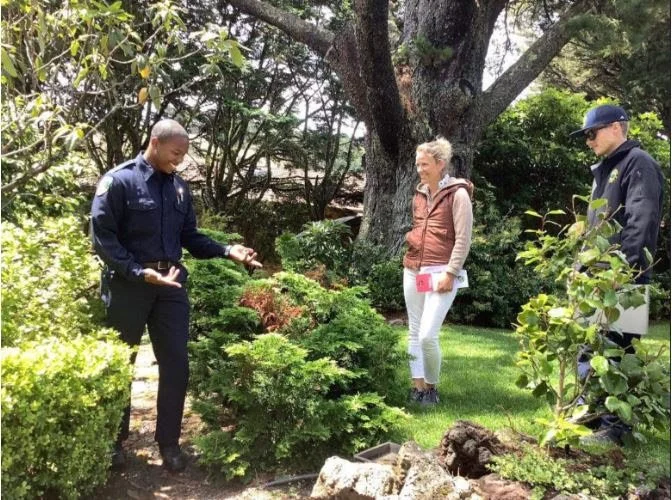Defensible Space Inspections
Inspectors will confirm that you have completed vegetation maintenance required by law. They will also provide recommendations for steps that may provide additional protection from wildfires. Property owners are required to maintain their properties; vegetation at all times during fire-season, and should not wait for an inspection to begin work.
You can access prior defensible space reports by visiting http://dspace.marinwildfire.org and entering your address. If you do not have your property’s unique code, follow the prompts to request one.
Online reports are only available to property owners, renters, and authorized representatives.
Evaluations are funded through Marin Tax Measure C (2020), Marin Wildfire Prevention Authority, and the Marin County Fire Department.
Please contact dspace@marinwildfire.org or (415) 275-1185 with questions or for assistance accessing an online report.
FAQs
What right do you have to inspect my property?
The California Fire Code and Public Resources Code grant the authority for the Fire Chief or authorized Fire Code Official to conduct inspections for compliance with the various applicable codes.
The inspectors do not enter a property without permission. They are trained to walk up to a front door (through an unlocked front gate at the street, if present, under rules of curtilage), and knock to introduce themselves. If no adult is present they will inspect the property as visible from the front door or public areas such as from the front pathway or roadway. Under no circumstances do the inspectors enter locked or gated areas of a property without permission of a resident or landowner, and they don't "peek" over fences. They only inspect areas that are plainly visible from a common area unless an adult resident gives permission to gated areas.
What are the exact laws I'm required to comply with?
California Fire Code 4907.1, 4907.2, 4907.3
What happens if I am unable to, or refuse to, comply?
Section 4907.4 of the CA Fire Code outlines the process to abate hazards if a property owner fails to comply. Your fire department would prefer to work with you to help you create a safe space around your home, so please contact us for assistance if you are unable to comply.
What is a FIRE HAZARDOUS plant species?
Plants that ignite readily and burn intensely (pyro-phases) typically share certain characteristics:
They are usually blade-leaf or needle-leaf evergreens.
They have stiff, woody, small or fine, lacey leaves.
Their leaves and wood usually contain volatile waxes, fats, terpenes or oils (crushed leaves have strong odors).
Their sap is usually gummy, resinous and has a strong odor.
They usually contain plentiful fine, twiggy, dry or dead materials.
They may have pubescent (hair covered) leaves.
They may have loose or papery bark.
These plants flame (not smolder) when preheated and ignited with a match.
FLAMMABILITY & CONDITION
The condition of the plant is as important as its species. Even some "prophetic" species can be quite fire-resistant if properly maintained. Depending on its growth form and access to water, the same species may be fire resistant in one environment and prophetic in another. Water-stressed plants that are in poor condition are more prophetic. A prophetic species becomes explosively flammable when poorly maintained. South-facing slopes, windy areas, sites with poor soils and urban landscapes are more stressful for plants.
PYROPHYTIC VEGETATION TYPES:
Grasses: Any cured (dry) grass. Nonirrigated, annual grasses are typically more flammable than perennial grasses. Irrigated grasses are fire resistant.
Herbs: Any cured herb.
Ferns: Any dry or cured fern, particularly cured bracken and sword fems.
Brush: Any brush with excessive deadwood. Any over-mature, dying or dead brush.
Trees: Any forest, stand or urban forest that is over-dense, under stress or over mature.
What else can I do to protect my home?
Hardening your home is just as important as Defensible Space. See www.firesafemarin.org/hardening-your-home for info.
See lots of other helpful tips at www.firesafemarin.org

